First: a disclaimer: We’ll be discussing comics published during a particularly incendiary period in our nation’s history. It’s no secret that the portrayal of minorities in all forms of American media in the 1940s was often stereotypical and demeaning, and the fervor of wartime patriotism during World War II ratcheted the rhetoric up even further. Accordingly, some of the artwork, language and situations are horribly racist and unacceptable when seen through the eyes of today’s reader. And let’s be honest: they were racist and unacceptable back then as well. However, these comics are a historical document of the culture, and to ignore or dismiss them because we now find some of the content distasteful is both irresponsible and a disservice to the fine work by these writers and artists that appears in these comics. For good or ill, this was America in 1942. That said, it’s time to meet the Air Fighters.
While we’ve mostly discussed the big boys of comics publishing in the 1940s, like National, Timely and Quality, there were a whole bunch of smaller operations also fighting for their piece of the pie. One such company was Hillman Periodicals. A publisher of both magazines and comics, Hillman had tried to break into the comics market in 1941 with the first issue of AIR FIGHTERS COMICS, which featured aviation-based adventurers. The book bombed. However, Hillman tried again a year later, and in AIR FIGHTERS COMICS #2 (November 1942), a brand-new cast of characters was introduced, this time with much greater success.
Although the timing certainly was a factor, as a post-Pearl Harbor America was probably much more interested in tales of our heroic fighters in the skies, the success of the series in the long term can certainly be attributed to its excellent art, as good and at times better than the work at National or Timely, and its first-rate characters, especially the series’ star and trademark hero, Airboy. But we’ll get back to him. First, let’s take a look at the other Air Fighters.
AIR FIGHTERS COMICS was made up of six features, plus one or two humor strips and usually a prose story thrown in to retain the lowest possible postage rate under a U.S. Postal Service bylaw.
Probably the most pedestrian of the features was “The Bald Eagle,” the adventures of flight instructor and troubleshooter Jack Gatling.
Gatling, a part-Indian stunt flier, earned his nickname when he lost his hair diving his plane through fire on a rescue mission. Gatling flew the “Flying Coffin,” a plane of his own invention that no one else dared to take off the ground. Like many of the Hillman stories, the early Iron Eagle stories are uncredited, so the writer and artist are unknown, but the storytelling is clear and dynamic, and the tightly plotted seven-pagers dealt with threats to the home front as often as battles in the air. In his very first story, for example, Jack deals with the mysterious dumping of hundreds of dead Japanese paratroopers over California. Or are they dead after all?
In “The Flying Dutchman,” readers would get a monthly dose of revenge as Jan, a.k.a. The Flying Dutchman, doled out retribution on the German forces who invaded his native Holland and bombed his home in Rotterdam, slaughtering his family. Piloting his orange Airacobra, the Dutchman would return to the skies of his native Holland at the end of each day’s combat, dropping a white rose for each Nazi he’d shot from the sky, letting his countrymen know they were being avenged.
The first “Flying Dutchman” story was drawn by Bob Fujitani, who mixed a slightly cartoony style on the faces in with all the action. Later “Dutchman” stories took a turn for the macabre, such as when the Dutchman contended with the Deathless Brain, a disembodied brain kept alive by machines, who commanded a fleet of Japanese fighters and bombers.
It’s never quite clear why the Deathless Brain was given a battle commission, but he’s effective enough until the Dutchman starts monkeying with his wiring.
Fred Kida provided the art on “The Iron Ace.” When Captain Ronald Britain of England’s Royal Air Force is shot down, he discovers a French chateau owned by scientist Dr. LaFarge, who shows Britain a suit of armor he calls “The Iron Ace, a legend of France.” When the last of his kin dies by the hand of an invader, LaFarge recounts, the Iron Ace will come to life and avenge him. Well, you can probably see where this is going, and soon enough LaFarge has eaten some Nazi lead, and Britain has donned the armor of the Iron Ace.
With his dying breath, LaFarge tells Britain of a plane he’s hidden in the cellar, in preparation for the Iron Ace’s promised return. Captain Britain finds the plane, a British fighter, and soon discovers that with the push of a button the plane is enshrouded in a “fabrikoid micro-iron” of LaFarge’s invention, rendering it impregnable, and allowing Britain to use it in flight as a battering ram. Britain returns with the plane, and regularly flies into battle against the Luftwaffe from then on in full armor as the Iron Ace.
Where would the Air Fighters be without a woman’s touch? Artist John Cassone delivered the sex appeal and then some with the adventures of “The Black Angel.” Drawn in a lurid pulp style that seemed almost a little out of place alongside some of the other, lighter features, “The Black Angel” was really British socialite Sylvia Lawton, who hid her trademark black fighter plane, skintight uniform and double life from her aunt, posing as a wilting young girl afraid of her own shadow.
The “Black Angel” stories really cranked up the sex and titillation, as evidenced in her very first adventure, in which she faced her Nazi counterpart, Baroness Blood. Aside from the subject matter, Cassone’s heavy inks and pin-up style of storytelling (it seemed like the Black Angel was always either changing clothes or leaning up against something…) set the feature apart from the rest of the book, to say the least.
As a response to Quality’s extremely popular BLACKHAWK series, Hillman came up with their own international squadron of freedom fliers in the feature SKY WOLF.
In their first appearance, drawn by Mort Leav, we meet Sky Wolf himself, the American leader of the squadron (recognizable by the wolf pelt he wears on his head, naturally), and his three companions: the tough little Brit Cocky; the Judge, an ace pilot rejected by the RAF due to his age, and the Turtle, a Polish pilot whose tongue was cut out by the Nazis, and who communicates with the boys via Morse Code, either in his plane’s transmitter or by knocking on his own head.
That, my friends, is commitment. The squadron flies in specially designed “semi-planes,” twin-pilot aircraft that can split into two separate fighters at a moment’s notice.
In their first appearance, Sky Wolf and the boys contend with the evil Nazi Half-Man, who lost the right side of his body (now replaced with steel) in an aerial duel with Sky Wolf, and his henchman Goro, the Yellow Butcher of Tokyo.
Like I said before, this wasn’t the kind of stories you were getting in Superman or the Justice Society at the time. National’s heroes were mostly battling Nazi saboteurs and bundists on the home front, and even the more hawkish Timely heroes like Captain America weren’t quite so overt in their demonization of the enemy.
In the Sky Wolf story, at the orders of Hitler himself, Sky Wolf is to be captured. Half-Man succeeds, and Sky Wolf is soon being tortured by Goro in one of the grislier scenes I can remember from comics, before Sky Wolf’s buddies, disguised as Hitler and Goebbels, manage to bust him out, with Goro receiving a taste of his own bloody medicine in the process.
It was also in the pages of “Sky Wolf” that the granddaddy of all comic-book swamp creatures appeared, The Heap. Yes, before DC’s Swamp Thing and Marvel’s Man-Thing came Hillman’s Heap, with an origin not too unlike his swampy descendants’. When WW I German ace Baron Emmelmann is shot down over a Polish swamp, Emmelmann’s sheer refusal to die causes his body to merge with the vegetative matter that makes up the swamp, giving birth to the Heap, a shambling monster that needed to draw the very blood from living creatures for sustenance. The Heap would wander through Sky Wolf’s adventures from time to time, usually snacking on Nazis that were threatening the boys.
As popular as the other features were, the breakout star of AIR FIGHTERS COMICS from Day One was Airboy. Created by Charles Biro and with art by Al Camy and later Dan Barry (of FLASH GORDON fame), Airboy combined just the right elements of youthful adventure, dogfight action and flights of fantasy to really click with the young readers of the time. In his premiere appearance, orphan Davy Nelson, Jr., is assisting Franciscan monk Brother Martier with a most unusual project: Martier is obsessed with building an aircraft with flapping wings like a bird, allowing for the ultimate in speed and maneuverability.
To fund the project, Martier takes out a loan on the property on which the monastery and orphanage resides, from crooked businessman Sessler. When Sessler realizes that the plane flies, and he won’t be able to foreclose on the loan, he sabotages the bird-plane, resulting in a fatal crash at the plane’s first public flight. Young Davy discovers the sugar in the gas tank of the wreckage, and realizes that Sessler murdered Brother Martier.
Davy throws himself into the rebuilding of the bird-plane, while Sessler builds a casino on what was once the monastery’s property. When the plane, or “Birdie,” as Davy dubs it, returns to the skies, Davy, now calling himself “Airboy,” bombs the casino to the ground. Nice.
Sessler runs into the burning casino to try and retrieve his money, but is soon consumed by the flames.
The Japanese soon learn of Airboy and the amazing Birdie, and dispatch their top ace Hirote to defeat Airboy and take Birdie for Japan, with no success.
In time, Airboy becomes an authorized if unofficial member of the Air Force, often going out on missions at the behest of the War Department. For young readers at the time, Airboy was bound to be a hit. Rather than the “sidekick” role that kids appeared in over at National and Timely, here the kid was the star, and not in a small way, either. He was shooting down Nazis and Japanese Zeroes and being treated like an equal by soldiers and generals. Forget being a sidekick, this was wish fulfillment! And the appeal of Birdie was huge. In later issues, a radio link was incorporated so that Airboy could call Birdie to come pick him up, and over time, this link between Airboy and Birdie was subtly stressed to such a degree that Birdie almost seemed alive, and would swoop down to save Airboy time and time again, snatching Airboy between his front tires like a bird’s talons.
But Airboy is probably best known for his femme fatale, Valkyrie, who we’ll meet next time…

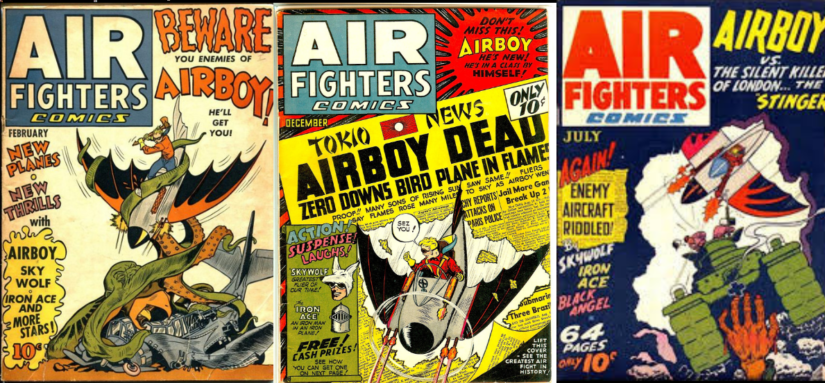





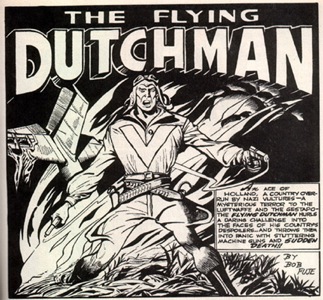


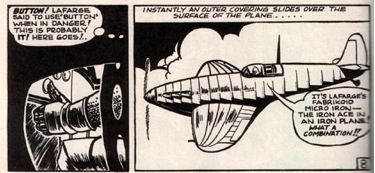

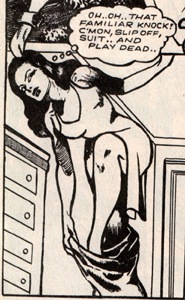
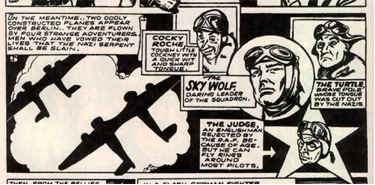

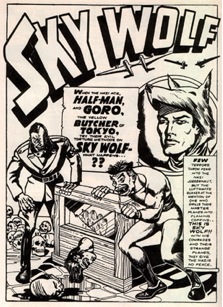
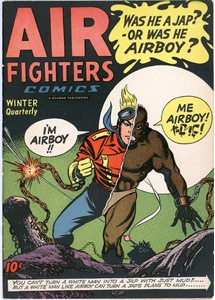


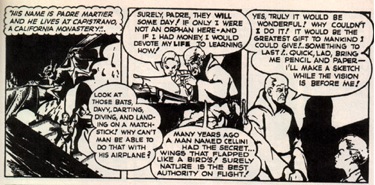


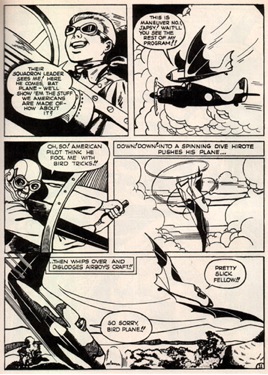
Comments are closed.